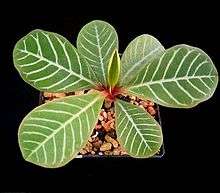Euphorbia leuconeura
Euphorbia leuconeura, the Madagascar jewel, is a species of plant in the family Euphorbiaceae. It is endemic to Madagascar. Its natural habitat is forest undergrowth in rocky areas. It can grow to a height of 1.8 m (6 ft), as a branching small tree, and propagates by shooting its seeds several feet into the air. It is threatened by habitat loss.[1]
| Euphorbia leuconeura | |
|---|---|
 | |
| Scientific classification | |
| Kingdom: | Plantae |
| Clade: | Tracheophytes |
| Clade: | Angiosperms |
| Clade: | Eudicots |
| Clade: | Rosids |
| Order: | Malpighiales |
| Family: | Euphorbiaceae |
| Genus: | Euphorbia |
| Species: | E. leuconeura |
| Binomial name | |
| Euphorbia leuconeura | |
| Synonyms | |
|
Euphorbia lathyrus (lapsus) | |
Taxonomy
The specific epithet leuconeura is derived from the two ancient greek words λευκός (leukós), meaning "bright, white", and νευρά (neurá), meaning "nerve".[2][3]
Cultivation
The Madagascar Jewel is grown as a houseplant for its attractive foliage: dark green leaves, with white veins when young. Unlike many succulents, E. leuconeura is less susceptible to overwatering. It grows best in partial shade but tolerates full shade and is relatively easy to care for providing it is not exposed to cold drafts.
Toxicity
When damaged, the plant secretes a white fluid which is toxic, causes severe skin irritation and may be a tumor promoting agent.[4]

| Wikimedia Commons has media related to Euphorbia leuconeura. |
References
- Haevermans, T. (2004). "Euphorbia leuconeura". IUCN Red List of Threatened Species. 2004: e.T44372A10896588. doi:10.2305/IUCN.UK.2004.RLTS.T44372A10896588.en.
- Bailly, Anatole (1981-01-01). Abrégé du dictionnaire grec français. Paris: Hachette. ISBN 978-2010035289. OCLC 461974285.
- Bailly, Anatole. "Greek-french dictionary online". www.tabularium.be. Retrieved December 17, 2017.
- Vogg, G.; Mattes, E.; Polack, A.; Sandermann Jr., H. (September 1999). "Tumor promoters in commercial indoor-plant cultivars of the Euphorbiaceae". Environmental Health Perspectives. 107 (9): 753–756. doi:10.1289/ehp.99107753. PMC 1566443. PMID 10464076.
